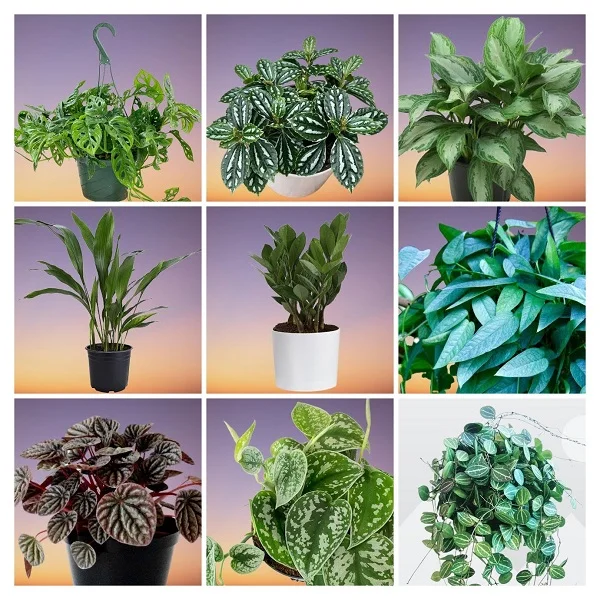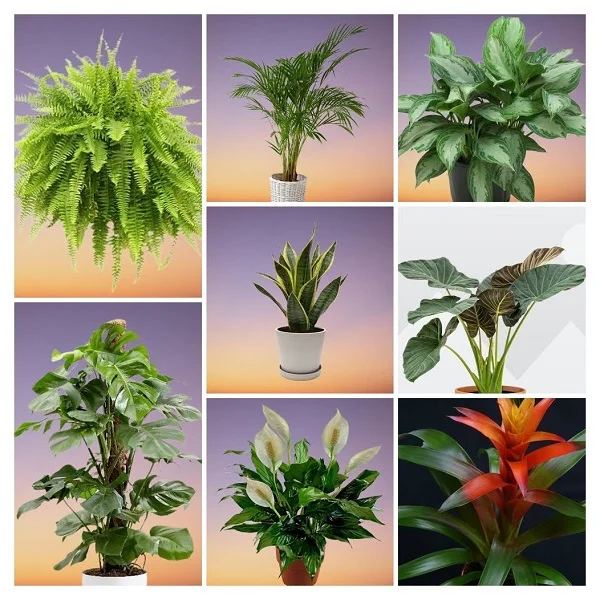How to Grow, Care and Propagate Davallia canariensis (Hare's Foot Fern)
Some links in this post may be affiliate links
Davallia canariensis (Hare's Foot Fern) prefers bright indirect light away from direct sunlight, average warmth and humidity and consistently moist, fertile, well-drained, all purpose soil coupled with fortnightly feeding in the growing season.
Hare's Foot Fern is a fascinating and unique houseplant loved for its furry rhizomes. In this guide, we will dive deep into everything you need to know about growing, caring for, and propagating Davallia canariensis.
Davallia canariensis is among the popular fern plants and is grown for its thick, scaly rhizomes which grow over the edge of the pot and resemble a hare's foot hence giving the fern its common name.
The rhizomes absorb moisture and nutients as they crawl. The fronds are broad, finely divided and look like carrot tops.
Hare's Foot Fern is one of the best plants for a hanging basket where the rhizomes can hang freely for maximum display. The rhizomes should not be buried under the soil as it can lead to rotting.
On account of its love for warm and humid conditions, Hare's Foot Fern is among the best plants for the bathroom as the atmosphere remains warm and moist.
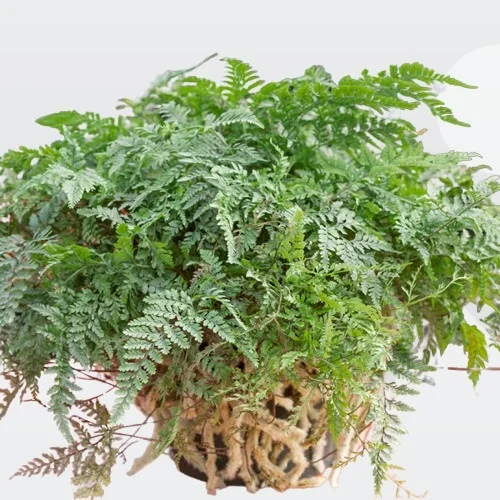
Botanical name: Davallia canariensis
Family: Davalliaceae
Common name: Hare's Foot Fern
Origin
Davallia canariensis is found from west Mediterranean to the Atlantic Islands where it grows in a sunny atmosphere and amongst the rocks. The species name, 'canariensis', suggests that this fern has its origins in the Canary Islands.
Size
Hare's Foot Fern grows to a height of about 1.5 feet and about 2 feet wide.
Is Davallia canariensis safe for pets?
Davallia canariensis are non-toxic to humans and pets as indicated by ASPCA. The plants are safe to grow indoors.
Related Species
Davallia canariensis is related to the larger but less hardy Davallia fejeensis (Rabbit's Foot Fern), Davallia bullata (Squirrel's Foot Fern) and Davallia trichomanoides (Black Rabbit's Foot Fern).
Where to Buy
Hare's Foot Fern are a great addition to any plant collection, they are available online on Etsy (Link to Etsy).
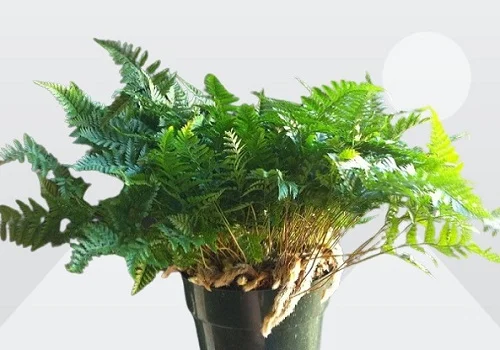
Davallia canariensis Care Indoors
Now, let's dive into how you can keep this fascinating plant happy indoors and how to propagate it. Davallia canariensis prefers bright indirect light (filtered light), average warmth of 21-250C, humidity of 60-70% and consistently moist, fertile, well-drained, all purpose soil coupled with fortnightly feeding during the growing season.
Hare's Foot Fern requires timely repotting as overcrowding can result in wilting and eventual death of the fern. Keep reading for more on these growing conditions and how to achieve them.
Watering
Water Davallia canariensis liberally during the growing season and allow the top 1-2 inches of soil to dry out between waterings to keep the soil consistently moist. Avoid overwatering as it can result in yellowing and rotting.
Cut down on watering during cold season as growth is minimal at this time to keep the soil slightly moist. Do not let the soil dry out completely to avoid crispy leaves and wilting and drooping fronds.
Maintain the rhizomes moist by daily misting. Ascertain that the pot has a drainage hole to prevent the soil from getting soggy as it can lead to rotting.
Light Requirements
Hare's Foot Fern grows best in bright indirect light (dappled light). Keep it away from direct sunlight as it may scorching resulting in crispy or pale fronds.
Davallia canariensis can tolerate some shade, but growth will slow. If the natural light is not adequate you may the fern under grow lights.
Rotate the pot regularly to ensure that the fern receives light on all sides for even growth and prevent lopsided growth.
Temperature and Humidity
Average warmth of 21-250C is ideal for Hare's Foot Fern. Temperatures outside this range can affect the growth negatively. Keep it away from drafts to avoid wilting, browning and excessive leaf drop.
Davallia canariensis thrives under high humidity of 60-70%. This fern is ideal for humid areas like a well-lit bathroom, kitchen, laundry are and other moist areas.
Too low humidity may cause browning of leaf tips and edges. To increase humidity mist the rhizomes more frequent to keep them moist, set the pot on a wet pebble tray or use a humidifier.
Fertilizer
Feed your Hare's Foot Fern with a balanced, water-soluble fertilizer every 4 weeks during the growing period for a lush growth. Stop feeding in the cold season as growth is minimal at this time and feeding at this time can lead to fertilizer burn.
Potting Medium
The best soil for Davallia canariensis should be well-draining soil that is rich in organic matter to prevent it from getting soggy while providing the required nutrients. All purpose potting mixes are good for the fern.
Pruning
Pruning Hare's Foot Fern involes removal of dead and damaged fronds. As the fern ages, the older fronds turn brown. Cut them off at the base to maintain the fern neat and tidy.
If the rhizomes get too long and scraggly, gently trim them back. But never remove them entirely as they actually store nutrients.
Repotting
Repot Davallia canariensis every 2-3 years at the beginning of the growing season. Use a pot that is 1 size larger than the current one.
Ensure that the pot has a drainage hole to prevent the soil from getting soggy as it can lead to rotting and eventual death of the fern.
The large fern can also be divided into several sections and potted individually to propagate new ferns. Take a look at these ceramic pots with a saucer on Amazon.
Davallia canariensis Propagation
Hare's Foot Fern propagation can be done by division of the rhizomes at the beginning of the growing season.
Propagating Hare's Foot Fern by plant division
- Carefully take the Hare's Foot Fern out of its pot.
- Locate natural separations between rhizomes.
- Use sterile scissors to cut a section with both fronds and roots.
- Pot these sections in individual pots while ensuring that you do not bury the rhizomes under the soil to avoid rotting.
- Place the pots in a warm, well-lit place away from direct sunlight.
- Maintain the soil moist through out until the new ferns are well established after which you can begin routine care.
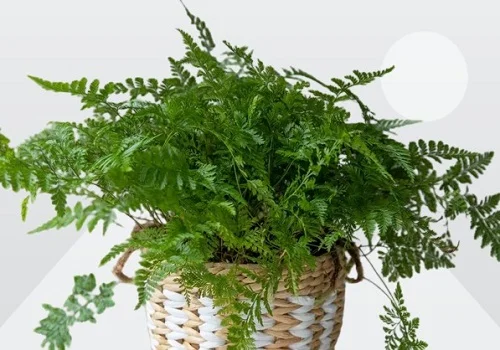
Hare's Foot Fern Problems & Solutions
Davallia canariensis problems include yellowing, brown leaf tips, wilting leaves, leaf drop, pests and diseases among others. Keep reading for more on these problems and how to fix them.
Pests
Common pests in Hare's Foot Fern are scales and mealy bugs. Isolate the affected plant to avoid spread to other plants and treat it with a horticultural oil as per the manufacturer's recommendations.
Brown shells scattered on the fronds
Brown shells scattered on the fronds of Hare's Foot Fern is an indication of a infestation by scales. Isolate the affected plant to avoid spread to other houseplants and treat appropriately.
Fronds yellowing, brown leaf tips and no growth
The cause of yellowing fronds, brown tips and no new growth in Hare's Foot Fern is dry air. To raise humidity mist the rhizomes more frequently to keep them moist, set the pot on a wet pebble tray or use a cool mist humidifier.
Yellowing leaves
Soggy soil is the reason for yellowing leaves in Hare's Foot Fern. Ensure the pot has a drainage hole and the soil is free-draining.
Wilting leaves
Wilting leaves in Hare's Foot Fern is an indication of overcrowding in the current pot. Repot the Fern into a larger pot or divide it up for more ferns.
Excessive leaf drop
Leaflets drop in Hare's Foot Fern is indicative of too dry soil. Maintain the soil consistently moist and do not allow it to dry out completely for an extended period of time.
Isolated brown and yellow leaves
Browning and yellowing in isolated areas of Hare's Foot Fern are as a result of excessive salts in the soil either from watering or fertilizers. Flush out the salts by repeatedly running a steady stream of water thorough the soil and avoid overfertilizing in the future.
Conclusion
Davallia Canariensis, or Hare’s Foot Fern, is a fascinating, low-maintenance plant that brings exotic charm to any indoor space. With the right light, humidity, feeding, and watering routine, this fuzzy beauty will thrive for years. And with easy propagation methods, you can share the love by growing new ferns.
Frequently Asked Questions
1. Can I grow Davallia canariensis in a hanging basket?
Yes. Hanging baskets allow the fuzzy rhizomes to cascade beautifully. Just ensure good humidity and indirect light.
2. Do Hare’s Foot Ferns go dormant?
Yes, in cooler months Hare’s Foot Ferns slow down growth. Water less frequently but maintain humidity.
3. How fast does Davallia canariensis grow?
Davallia canariensis is a slow to moderate grower, but once established, the rhizomes spread steadily.
4. Can I grow Davallia canariensis outdoors?
Yes. Davallia canariensis can grow outdoors but only in warm, humid climates (zones 10-11). Otherwise, it is best kept indoors.
5. Why are my Davallia canariensis rhizomes drying out?
This could be due to low humidity or underwatering. Increase humidity by misting or by use of a humidifier. Do not allow the soil to dry out completely; water when the top 1-2 inches of the soil dry.
You liked it? Share on social media.
Related Content
Amazon Associates Disclosure
Homeplantsguide.com is a participant in the Amazon Services LLC Associates Program, an affiliate advertising program designed to provide a means for sites to earn advertising fees by advertising and linking to amazon.com.



